 Uberstreichen – it’s a hard word to pronounce, but one that shouldn’t frighten you! This useful addition to your vocabulary will provide yet another test to check your progress- and German trainer, CHRISTIAN THIESS makes sure that while Uberstreichen will remain difficult to say- it is easy to understand, and better still, easy to apply!
Uberstreichen – it’s a hard word to pronounce, but one that shouldn’t frighten you! This useful addition to your vocabulary will provide yet another test to check your progress- and German trainer, CHRISTIAN THIESS makes sure that while Uberstreichen will remain difficult to say- it is easy to understand, and better still, easy to apply!
Sometimes, some trainers contribute only to their student’s confusion and doubts – when they should be increasing their understanding.
Maybe you’ve experienced just such a situation where a trainer, maybe even a so-called ‘riding master’, throws a barrage of technical terms at you – without sufficiently explaining them. Instead of extending your knowledge he succeeds only in building up an aura of mystique!
Dressage is presented by these people not as a harmonious development of the horse’s abilities, but as an incredibly complicated ritual that ‘normal’ people haven’t a hope of understanding. And although many pupils become totally baffled, they are often too scared to admit their doubts for fear of embarrassment- they are like the crowd in Hans Christian Anderson’s fable -The Emperor’s New Clothes.
If this ever happens to you, don’t be too scared to stand up and say your knowledge of a certain point is cloudy. Any trainer of real value must be able to clearly explain:
– Precisely how to do something
– Why it should be done
– Why one particular method is more appropriate than another
– And its place in the horse’s preparation
The trainer’s technical knowledge must be sound, so he should welcome your intelligent queries and not gloss over them.
Nothing in riding should be surrounded by mystique. The classical equitation is based on logical construction that has been developed over the centuries and has survived simply because it produces the best results in the harmonious development of the horse.
Riding is a logical skill which must be learned and practised just like any skill. However riding can go one step beyond for it is possible to produce an art expressing effortless power, harmony, elasticity, rhythm and lightness. Then riding has gone beyond being only a skill, and the rider is more than just skillful – he is an artist.
But to become an artist, you must master the skills. You must understand the theory and the connections and interactions associated with dressage. No mystique, no confusion. A good teacher with a firm knowledge is required to transmit the information logically.
Avoid those teachers that like to display their superiority by using obscure terminology – right through from half halts and cadence to foreign words like Descent de Main and Losgelassenheit, without being able to clearly explain their meaning!
One term that has sometimes been included amongst the barrage is Uberstreichen. Maybe you’ve heard it and are uncertain about its meaning and value in the preparation of a horse. If so, I would like to help clarify the points. Most likely, Uberstreichen (pronounced oubershtriken) is a new word for you – in which case I would like to introduce you to this valuable riding aid, but without any mystique or confusion.
Unfortunately the word has no easy translation into English, so it is best to become familiar with the German pronunciation and include it with your list of riding terminology – but as a word you fully understand.
Uberstreichen is used by riders to find out if their horse is correctly on the aids and balanced at trot and canter. It is very simple to execute.
The rider simply interrupts the contact momentarily with the horse’s mouth by stretching his hands forward. It is essential to maintain the driving leg and seat aids and not to alter the upper body position. Only the arms and hands should move forward in the direction of the horse’s mouth. The contact should be broken for two to three strides and then resumed without snatching at the reins but simply bringing the hands back to their usual position.
There are two different types of Uberstreichen – one where both hands are stretched forward simultaneously and the second where only the inside hand is pushed forward while the outside hand maintains the contact.
Before we progress let us clarify exactly what is required for the horse to be on the aids. He must be on the bit, engaged, working from behind and straight, so the impulsion can flow through his body without resistance into your hands via his mouth. This means he must be willingly accepting the bit.
If all the requirements are fulfilled when you Uberstreichen with both hands, the horse will stretch his face line in front of the vertical as he seeks to maintain the contact with the bit. He will show a tendency to momentarily lengthen his frame, but he will maintain the rhythm and tact of the trot or canter.
This is the ideal; the response we are looking for that assures us everything is OK. The warm up is progressing well. The horse is engaged, straight and working without resistance. Providing we are happy we can progress to more demanding work in the session.
However if you Uberstreichen and your horse’s response is not correct, it is time to analyse precisely what is wrong and to remedy the problems before trying to advance to more difficult work.
One of the most common faults is when the horse comes above the bit, or tries to throw his neck up or down during the Uberstreichen. This shows he is not correctly on the aids but has been pulled together from front to rear… with too much hand and not enough leg and seat. The horse has been forced into an unnatural position which only provides a false impression of being on the bit.
Unless he is driven from behind into the hand all his work will suffer from a lack of impulsion and true acceptance of the bit.
If this happens to you, you must use stronger leg and seat aids appropriate to the situation to drive the horse into the restraining hands. Check that you are correctly coordinating your half halt with leg, seat, hand, followed immediately by a slight momentary relaxation (give). Concentrate and visualize that you are pushing the horse from behind into the bit, not pulling him.
Sometimes the problem is aggravated because the horse doesn’t understand or accept the leg aids. This is especially common with ex-racehorses who have been conditioned to flee from leg pressure instead of maintaining their rhythm and tempo and responding to the driving aids by generating more impulsion. If your horse does not accept the leg and becomes tense when it is applied, or does not respond at all, then you must overcome this very serious fault before you can make any progress.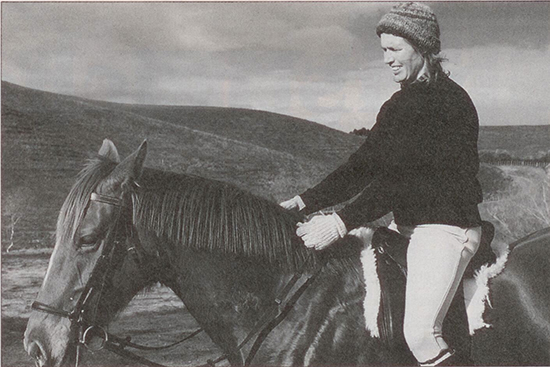
Correct Technique. The rider has stretched her arms and hands forward in the right direction and the contact with the horse’s mouth has been interrupted. The rider has not altered her upper body position during the Uberstreichen. The horse has come in front of the vertical as he seeks to maintain the contact with the bit.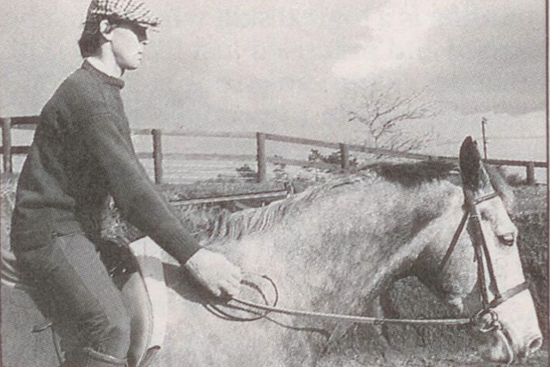
Incorrect. The Rider has stretched his hands too low and the contact has not been interrupted. The rider’s upper body has fallen forward and the horse has come above the bit.
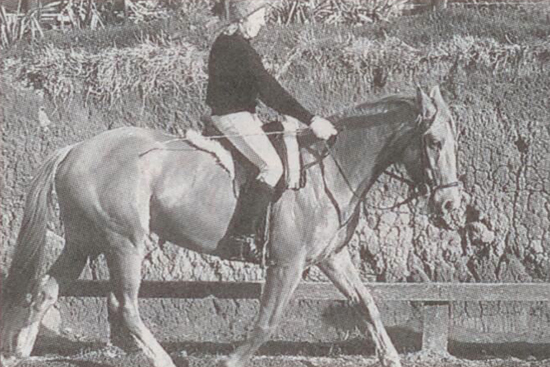 Correct technique and response at the trot…
Correct technique and response at the trot…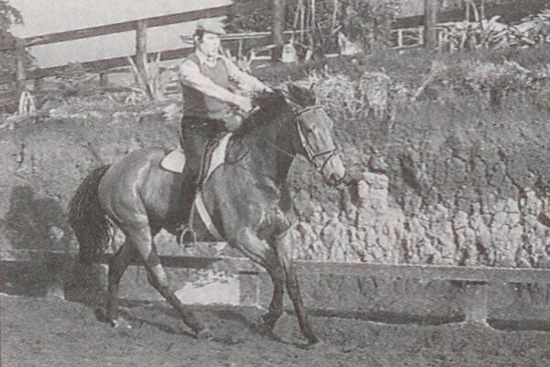
…and at the canter.
Another fault is revealed when the horse does not alter his head position at all throughout the Uberstreichen. He maintains his faceline on the vertical instead of stretching it slightly forward and shows no tendency to lengthen his frame or seek the bit. This is very bad and an accurate alarm signal that your horse is restricted in himself, or worse still, is behind the bit.
(It is worth noting the difference between coming behind the vertical where the horse’s faceline drops behind the perpendicular but he maintains the contact and behind the bit, where the horse drops the contact with the bit when he comes behind the perpendicular. The latter is a more severe fault and more difficult to correct.)
If the horse does not alter his head position in response to the Uberstreichen, then it is important to take immediate action to try and remedy the situation. Both indications show the horse is not moving freely forward and accepting the contact. He is not engaging his hindlegs and is avoiding the work, so ride him forward, urge him on with leg and seat. Make sure you use the flat of your calf when you apply your leg aids and if your horse doesn’t respond, touch his side slightly with the spur. If the response to the leg is still dead or delayed, remind him with a short sharp tap with the whip behind your boot – rather than further numbing his response with a futile drumming of your legs.
Concentrate on getting him active, on sending him rhythmically forward and literally driving him up to the bit. Then Uberstreichen again. If he stretches and seeks the bit, it is a sign that all is well again. If not, continue to urge him forward to the bit, encourage him strongly to engage his hind legs. Uberstreichen again to test and again and again if necessary until you have achieved your aim.
Don’t become discouraged if you horse does not come right straightaway, because to correct a horse who comes behind the bit, or restricts himself, takes time… usually more than one lesson. Sometimes weeks or months. However Uberstreichen and ‘the proof stones’, especially showing your horse the way towards the ground, will help monitor progress. Time spent now correctly establishing the basics will be amply repayed when the advanced work begins.
If your horse is in self carriage he will maintain the same trot or canter rhythm when you Uberstreichen. If he alters his rhythm, hurries, or worse still, runs, he is not carrying himself or working in balance. In this case he will be on the forehand and have the tendency to lean on the rider’s hand. He will be using the bit like a fifth leg and will become heavier and heavier in your hands.
Let me clarify my explanation by using an example. Perhaps you’d like to try this experiment with a friend. Place a rope around your waist and have your assistant hold the two ends behind (just like the game, children sometimes play). Now both walk forward with poise and balance. If your assistant suddenly stretches his arms so the rope becomes slack, what will happen?
Nothing! You are moving independently and with balance, so you will not be disturbed. But now try leaning on the rope so your assistant has to support you. If he suddenly stretches his arms forward, you will fall on your nose. The only way you will be able to prevent this is to speed up, to run forward with short steps.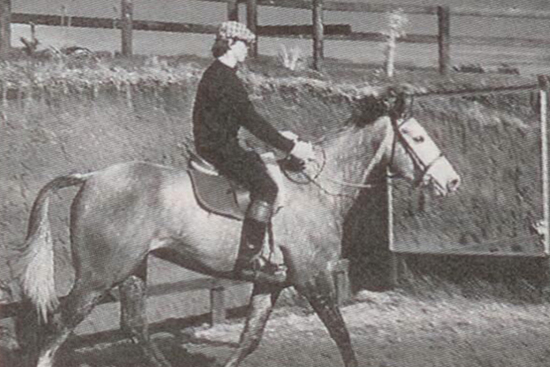
Incorrect. The horse has come above the bit during the Uberstreichen.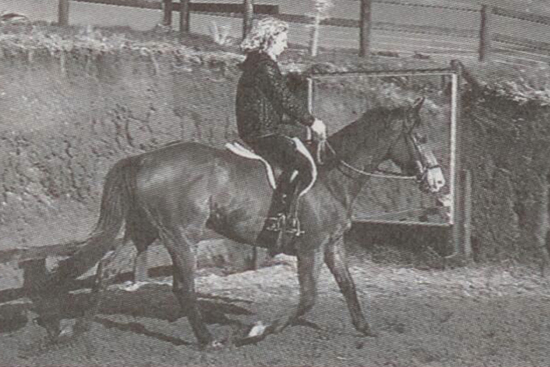
Incorrect. An example of a horse on the forehand who was leaning on the bit. During the Uberstreichen he has lost the support of the reins and consequently he has begun to run and lose the rhythm.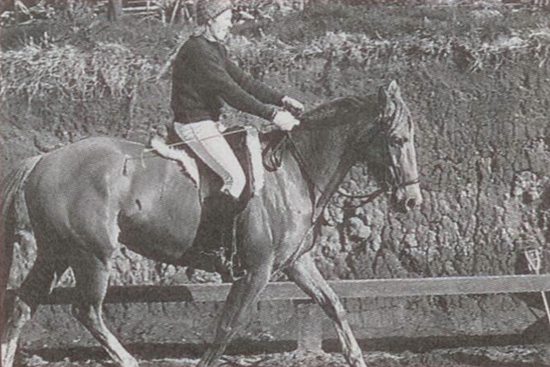
Uberstreichen inside. Good technique and response. The horse has maintained the bend correctly.
How can you regain your balance? Only by shifting your centre of gravity back, by taking bigger steps and engaging your legs under your body. Although the situation is not exactly the same as when you are on your horse and he is leaning on the bit, the reaction is comparable. When you Uberstreichen, your horse loses the support of the bit he was dependent on, and runs with choppy strides.
The only way the horse will be able to regain his balance is through engaging and carrying more weight on his hindlegs to lighten the forehand. Effectively you must try and influence him to shift his centre of gravity back. Use your legs and seat to encourage him. Take the horse on the circle and encourage him to bend his inside leg – push it under his body more. Prevent any falling out with your outside leg and rein, and your horse’s outside leg will easily be able to follow the inside hind.
Now try the Uberstreichen again. If your horse maintains his rhythm then everything is alright. If he still hurries or runs, repeat the whole procedure again. Uberstreichen again to check the result and work, work, work until you achieve your result. Don’t give up. To perform correctly, your horse must be well-balanced.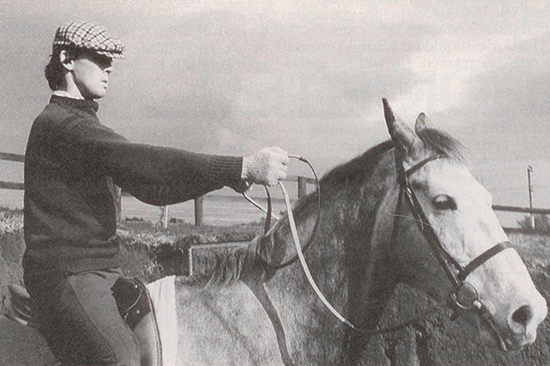
Incorrect Rider Technique. This rider has stretched his hands in the direction of the horse’s ears instead of towards the mouth. The horse has come above the bit.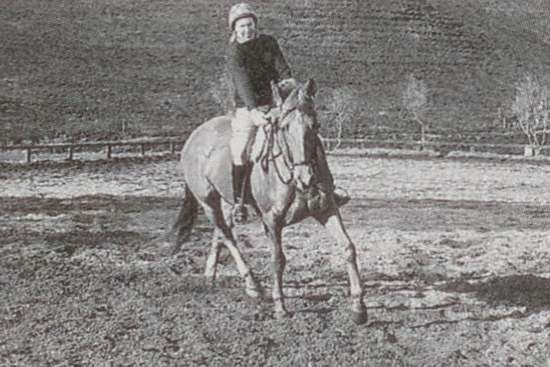
Uberstreichen inside from a different angle. The rider has exaggerated the stretching of her arm and as a result her upper body position has altered. Despite this the horse’s response is correct as he has maintained the bend and rhythm.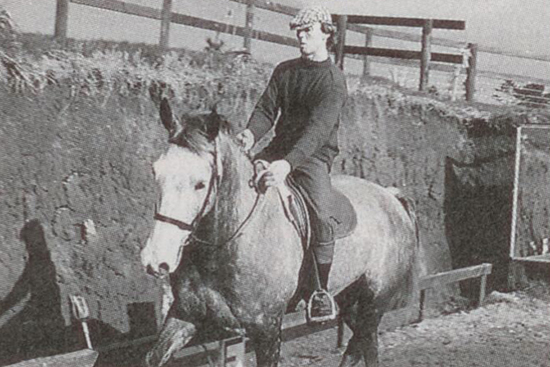
Uberstreichen inside. Bad! The horse has lost the bend which is proof that he is not accepting the outside rein.
The Uberstreichen with the inside hand is used to test if the horse is correctly accepting the outside rein. The technique is similar to the two hand Uberstreichen. The rider simply stretches his inside hand in the direction of the horse’s mouth to interrupt the contact for two to three strides – at the same time he maintains the contact with the outside rein in conjunction with the forward driving aids. The horse’s body position should not alter.
It is best to use the inside Uberstreichen on the circle or a curve line, such as serpentines or corners. First flex your horse correctly with the right amount of bend appropriate to the diameter of the curve you are riding. When you Uberstreichen with the inside rein, the horse should maintain the bend. If he turns his head to the outside and loses the bend, you have proof that he is not accepting the outside rein.
To overcome the problem, you must engage his inside leg and push him into the outside rein. Make the horse accept the contact. Then try the Uberstreichen again. If he maintains the bend then you have overcome the problem. If not, try and apply precise aids, correct half halts, until the horse does accept the outside rein.
The most common fault here is a rider one. A lot of riders do not bend their horses correctly on curved lines… and how can you check that your horse maintains the bend, if you don’t bend him in the first place?
The Uberstreichen is especially useful in the last part of the working in phase. Use it every day before you begin the fundamental stage of the session. The horse should be warmed up and his muscles relaxed. He will be at the stage where he is accepting the rider’s leg aids so the rider will be able to drive and to push the horse from behind into the bit. The horse will be beginning to engage better from behind. He should be moving forward rounded and with a good rhythm and full of elasticity. To the rider, he should feel light but powerful. The impulsion created from the hindquarters should flow unrestrained through his swinging back, neck, mouth and into your hands.
Now the serious work of the session can begin. The straightening, the concentrated suppling exercises, transitions, extensions and collection. But first check that your horse is 100% ready! Make sure he doesn’t need a few adjustments, some ‘fine tuning’, before you launch into the more demanding work.
Now is the time to use the Uberstreichen. Is your horse carrying himself? Is he engaging his hindlegs? Or is he still on his forehand? Is he accepting the bit, or are you pulling him together with your hands? Is he stepping forward into the bit, or is he restricted in himself, or worse, behind the vertical? Does he accept the outside rein, or only create the impression that he does?
The Uberstreichen will answer these questions clearly for you. You will then be able to take action according to the circumstances and solve any problems. Then your horse will truly be ready to work correctly… he will be tuned in preparation for the concert.
The Uberstreichen will also help you during your warm up at competitions, and at any time you are slightly in doubt about the answers to the above questions. In addition, it is a useful aid for relaxing young or exciteable horses and for quickly alleviating the first signs of tenseness that can appear sometimes in any part of a training session.
The Uberstreichen, a new word for your vocabulary; a test that tells no lies.
Common Rider Faults During the Uberstreichen
To help you master the correct Uberstreichen technique, here is a list of common faults you should avoid:
* The rider fails to stretch his arms far enough forward and consequently the contact with the horse’s mouth is not interrupted. The reins do not become slack.
* Instead of stretching the arms towards the horse’s mouth, the rider stretches them towards the horse’s ears (like crest release), or stretches them towards the rider’s toes.
* The rider alters his upper body position during the Uberstreichen. It is especially common to see riders fall forward, loading the horse’s forehand.
* The rider fails to maintain the forward driving leg and seat aids. As a result the horse loses the engagement and impulsion and alters the rhythm (slows down or hurries). The beneficial testing effect of the Uberstreichen is lost. All the above apply to both the two handed and inside Uberstreichen, but there are two additional faults that can occur with the inside Uberstreichen.
* The rider fails to bend the horse sufficiently before the Uberstreichen.
* The rider drops the contact with the outside rein.
Be careful not to confuse the Uberstreichen with the Descente de Main, which is mentioned in some books. Its practice was described by Francois de la Gueriniere, and it is used in very advanced equitation.
Descente de Main is a form of Uberstreichen in that it involves an interruption of the rein contact, but the rider’s leg aids and the correct response of the horse are quite different.
Before the Descente de Main can be of benefit the horse must have achieved a very high level of collection and self carriage, for example, in the correctly ridden piaffe or levade. The Descente de Main will fully test if the horse is truly collected and working with poise and self-carriage, or if the rider has forced the horse.
The rider must diminish the pressure on the reins by slightly opening his fingers and allowing the reins to slide out. They should only lengthen to the extent of their weight, but this will be sufficient to allow them to slacken. The rider’s leg aids must become passive while he maintains the horse with braced back. The horse should continue the highly collected exercises without any modification to the rhythm, impulsion, outline and degree of collection. The horse should give the impression of continuing the movement by himself, although the rider will really be in full control through the finesse of his aids.
The most common error occurs when riders misunderstand the theory and the aim of this exercise. They try to perform the Descente de Main with a horse who has been pulled together and is therefore restricted in himself, or worse, behind the bit. Such a horse will maintain the same outline when the contact is broken, but he will not fulfill the other requirements. The horse will be tense and show a lack of engagement, impulsion and collection. He will be a caricature of a well-schooled horse and will only fool the ignorant.
Another French term not to be confused with the Descente de Main is the Descente d’Encolure. Some people consider it an exercise somewhere between ‘showing the horse the way to the ground’ and the Uberstreichen. In some ways this confusion is not surprising as people also manage to muddle the aims and techniques of these two exercises with each other. In reality, the Descente d’Encolure is the French expression for ‘showing the horse the way towards the ground’.
This article first appeared in the December 1985 issue of THM.
For more from Christian, go here:


